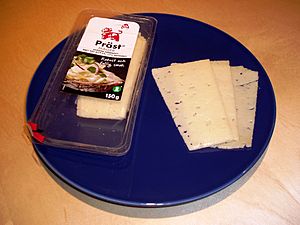Prästost facts for kids
Prästost (which means "priest cheese") is a special Swedish cheese. Its history goes back to a time when people in Sweden used to pay their taxes with farm goods, like milk. Since milk spoils quickly, most farms made a small cheese with holes (called "eyes") in it. They started the cheese-making process by mixing in a small amount of already fermented milk curds. This way of making cheese was common from the 1500s to the 1800s. Today, this type of cheese, which was once made in churches across Sweden, is produced in factories using pasteurized cow's milk.
Sometimes, Prästost is soaked or aged in whisky or other spirits to give it a unique flavor. For example, Saaland Pfarr is a version of this cheese that has been soaked in whisky. Another special version, called VODCheese, is aged for 12 months and cured using Absolut vodka to add a distinct taste.
How Prästost is Made
A booklet from 1969 by the USDA described how one type of whisky-cured Prästost was made:
- First, fresh, whole milk is mixed with rennet (a special enzyme) at about 90°F (32°C).
- When the milk turns into a very firm curd (like soft cheese), it is cut into large pieces.
- Then, the curd is placed in a sieve to let the whey (the liquid part of milk) drain away.
- The curd is gathered in a cloth and kneaded to squeeze out even more whey.
- Whisky is then mixed into the curd.
- Next, the curd is packed into a basket, and salt is sprinkled on top.
- The cheese is then aged in a cool, damp cellar.
- The cloth covering the cheese is changed every day for three days.
- After the third day, the cheese is washed with whisky.
See also
 In Spanish: Prästost para niños
In Spanish: Prästost para niños


